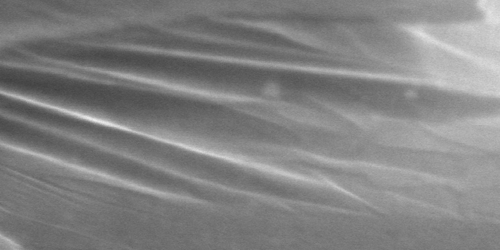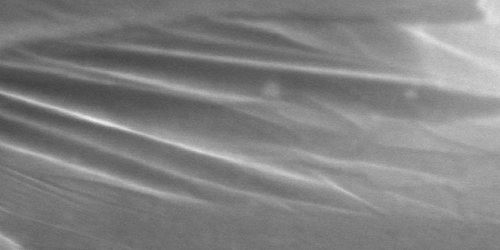Crumpled Graphene
Graphene is the strongest known material thanks to its stiff carbon-carbon bonds. But its strength can be compromised by “wrinkles.” New experiments on stretched graphene sheets find that their stiffness (the resistance to stretching) depends on how much the sheets have already been stretched. The explanation is that graphene starts out crumpled and only exhibits its super strength when it is flattened out by a sufficient amount of stretching. These observations imply that a reassessment may be needed for the planned use of graphene in nanoelectromechanical devices.
Theorists have extensively studied crumpling of graphene, but few experiments have measured the effect of graphene’s wrinkles on its mechanical properties. Kirill Bolotin from Vanderbilt University, Tennessee, and his colleagues have performed experiments on free-standing graphene sheets, as well as on sheets flattened through strain engineering. The sheets were used to seal a hole in the top of a chamber of nitrogen gas. When the gas pressure was increased, the graphene membrane bulged outward. The team characterized this stretching using spectroscopy to capture changes in the lengths of the carbon-carbon bonds and interferometry to measure the long-range stretching over micrometer scales.
For the strain-engineered sheets, the measurements implied a stiffness of around 430 N/m, which agrees with previous observations. The same stiffness was found at high pressure in the free-standing sheets, but at low pressure, the long-range stiffness was significantly smaller. The team showed that this softness could be explained by wrinkles that disappear when graphene is stretched. By comparing their data to crumpling models, the team showed that the wrinkles are static distortions rather than dynamic ones caused by vibrations (phonons).
This research is published in Physical Review Letters.
–Michael Schirber
Michael Schirber is a Corresponding Editor for Physics based in Lyon, France.





